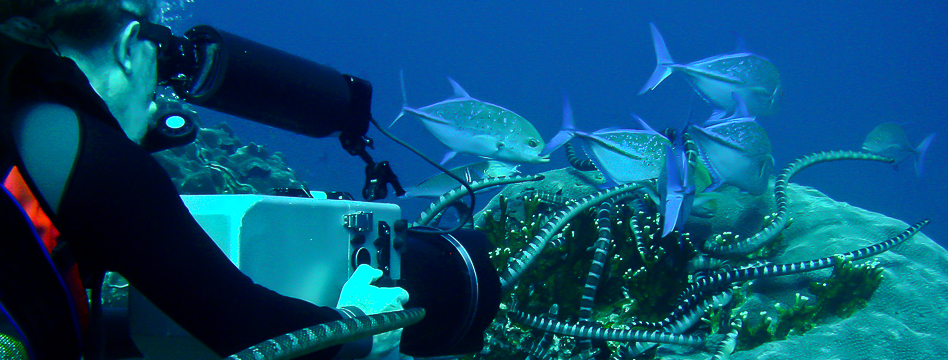 October 2005
October 2005
A private charter with the BBC’s number one coral reef film maker Peter Scoones and assistant producer Emma Rolfe (now Emma Pearce). Heading out to tiny island for nearly two weeks, filming for the BBC’s next huge project called Planet Earth.
The Shallows Seas portion of Planet Earth was aired November 2006 and is now available on DVD…
I knew it was only a matter of time before a professional film crew would want to get out to this unique island. I knew that this island had a very special and most unique attraction – vast quantities of sea snakes that live here all year round.
Diving 4 Images had various inquiries wanting to film this unique island… then a very serious inquiry came in. After a few months of emailing back & forth and a few long distance phone calls, a suitable boat was found at the right rate. Even though I knew the snakes were harmless to divers, no risks were to be taken with this team. We had all the nessasary contacts for a quick evacuation if needed, then we had to see if we could source anti venom, we eventually found this a week or so prior to departure. We all met the evening before our departure to go over any final requirements, the film maker Peter Scoones and researcher Emma Rolfe (now Emma Pearce). All in very good spirits on our first evening out, maybe we would even have a few laughs along the way too? In the morning we were off, we had arranged, with guarantees to make sure the all the 250kg of luggage would arrive. Our prior arrangements made sure the luggage all arrived without any issues.
Two flights starting from Bali to Kupang the over to Alor, we were on the boat mid afternoon and off we went on our way into the deep blue open ocean of the Banda Sea. Currents were against us just about all the way and a bit of choppy ocean slowed us down. This was not the fastest of boats at the best of times, it took us longer than planned to finally reach Gunung Api, all no problem as we had allowed plenty of filming time.
On arrival we arranged for the safest and most appropriate of the 2 anchorages I had scoped out on previous trips through here. Once we safely anchored in and tied to the shore we headed out to make our first dive. This was more of a check dive really, making sure all the filming gear was working right, everything was working fine… During the first two full dives on our first day we never came across the huge agregations of snakes I had seen in previous years. Though snakes do move around, I knew it would only take us a dive or so to find the hottest spot for the best snake activity.
On our first full day of diving, I went off to explore another one of the many ridges I knew on the island, another known for sea snake activity. This turned turned out to be the very hot spot we were looking for with plenty of sea snakes all over the place in large numbers! Peter dropped in while Mark and I installed buoys so our tender boats could be close at hand at all times without wasting fuel. We were going to be here for a while and wanted to make life as easy as we could! Peter managed to get some excellent footage with perfect lighting. We had clear blue skies and managed to make a few dives with very little current before needing to opt for a second choice of site due to conditions. At the end of this day we were all very hopefully for another great day…
We awoke to a very cloudy day, terrible for underwater filming, never the less, we carried on to see if we could search out some interesting sea snake behaviour. We did come across a sea krait that seemed was was actively feeding, but for a big production we needed BIG drama, BIG action, BIG TIME activity… and all with the best possible lighting!
Another morning and even worse weather. It had rained all night. The wind had turned, blowing right in to the small bay where we were anchored, so much so that we needed to move to another location for a safer anchorage. As we headed out for our first dive, Peter seemed in fairly low spirits, all due to the lack of light. What we saw though really made a difference, we came across the kind of behaviour that the BBC was after. A big aggregation of snakes were following blue fin trevally that were following a school of yellow saddle goatfish.
Sea snakes feeding with jacks and goatfish on Gunung Api
This was not just drama, it was really colourful too, plus the snakes were very active in searching out food, it was hard at times to see who was going in first. This was the kind of action we were after. The next dive we had some snake feeding action. On earlier dives we had noticed that the snakes seemed to follow one diver more than anyone else, was this colour related, smell related or what… maybe it was Mark Chambers (divemaster) special Balinese aftershave, we never knew? On this dive though, the snakes seemed to be really interested in following me. Groups of 20 or more snakes were directly behind me at one point.
Even though we had very poor lighting Peter managed to make the most of what was there, he took some high quality snake footage. Peter had brought along his high definition monitor. Looking over the rushes that evening was great, it looked fantastic. He had the main behaviour on film already. The sky cleared in the evening, the crew rigged up a screen and speakers so Peter could set up his projector on the deck and we watched a film. What was it we watched, of all the films you can imagine you wouldn’t believe this – Wallace & Grommet, Peters favourite!
We awoke to a clear day all hoping it would stay with us for more great filming. The first dive was another very productive one, this time with even more feeding behaviour. We were managing to find excellent snake behaviour on most dives now, when we had conditions that allowed that is. We were monitoring the tides and currents and we did find a certain pattern starting to emerge! Though being a very small island in the open ocean it does seem to have it’s own rules regarding currents, when and where they would be at their strongest was just not predictable enough. Once we had worked out what the currents were up to we timed our dives as best we could, yet still the only predictable thing was our hot spot, great snake action on every dive. We had searched all around the island and I created a fairly thorough map of the best sopts on the island for future referance. We never managed to find another hot spot, but what we did find was many great spots for dive sites. One area with a huge school of swirling jacks, area’s with gorgeous reef scenery, great soft coral walls, amazing shallow hard coral gardens, there is actually much more to this island other than snakes.
The next few days we managed to judge the tides fairly well to avoid the majority of the current. However we still got caught out slightly as the current came up strong at the end of a dive. The snake footage shot over the next few days was just what Peter and Emma were after. They had the sequence they were after from this trip well within the time we had planned, still we headed out to try and better certain shots and add a few more that may help the sequence even more. Peter managed to take even better shots of snakes with the best possible lighting.
Just when we thought we got to know and understand the currents here, they started to change like the weather on a typical day in England. On a few dives before we left we managed to see the current change 3 times during one dive.
The last task was for Peter to take some production stills that would possibly go forth to promote and advertise the future show Planet Earth. As expected with so many snakes on this hot spot, Peter managed to get plenty of good images from the new Nikon D2X digital camera, he’s not just a great film mater, this fella creates damn good still images too!
Peter took the video while I took the stills camera to see if I could get a few more shots action shots of snakes, jacks and goatfish. The action was once very good, this time a few lionfish were amongst the action, whether the lionfish were actually in the group as a result of the group entering their territory we never found out. I shot as many action shots as I could…
Then I noticed a huge female come into view. This snake swam off, only to be followed by a smaller male, then as I watch the small male wrapped its body aorund the larger female. I went crazy with my underwater buzzer to attract Peters attention, it would be great if he could get this on film. WHile Peter was on his way I managed to shoot a few shots of the mating snakes with the stills camera. Now this was a yeehaaah dive indeeed!
Conclusion
The trip went so well that Peter had shot enough footage to eventually go towards creating a great sequence, and all well within the time we had allowed for the charter. We even found mating sea snakes on our last day. Now I can’t wait to see the next great BBC production — Planet Earth!
Click here to read their comments


Your point of view caught my eye and was very interesting. Thanks. I have a question for you.
Your article helped me a lot, is there any more related content? Thanks!
Thank you for your sharing. I am worried that I lack creative ideas. It is your article that makes me full of hope. Thank you. But, I have a question, can you help me?
Your article helped me a lot, is there any more related content? Thanks!
Your point of view caught my eye and was very interesting. Thanks. I have a question for you.